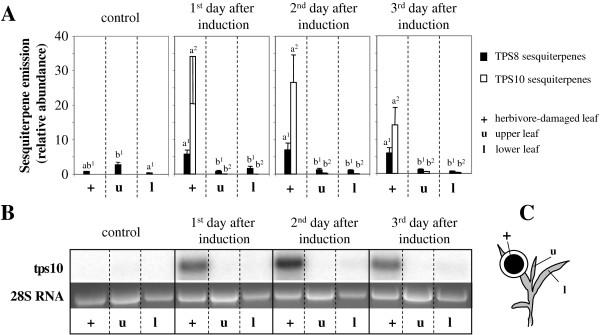Figure 1.

Variation in volatile sesquiterpene emission and terpene synthase transcript levels between herbivore-damaged vs. neighboring control leaves. (A) Terpene volatiles emitted from herbivore-damaged leaves (+), the leaves immediately above the damaged ones (u) and the leaves immediately below damaged ones (l) of the maize inbred line B73 collected one, two or three days after induction with Spodoptera littoralis caterpillars. Volatiles were collected using SPME and analyzed by GC-MS. Sesquiterpenes were classified in two groups: TPS10 sesquiterpenes including (E)-α-bergamotene, (E)-β-farnesene, and β-sesquiphellandrene and TPS8 sesquiterpenes including α-copaene, (E)-β-caryophyllene, germacrene D, and δ-cadinene. Means and standard errors (n=3) of three independent measurements are given. Different letters with the same numbered superscripts (e.g. a1 and b1) indicate statistically significant (p<0.05) differences between the herbivore-damaged leaf, the upper leaf and the lower leaf for each terpene group and time point. (B) Expression of tps10 transcript in S. littoralis-damaged and neighboring control leaves over the same time course. RNA was prepared from leaf samples as described in the methods, blotted and probed with a radio-labeled tps10-specific PCR-fragment. Images were obtained with a phosphor imager. (C) Experimental setup showing cage for S. littoralis larvae on herbivore-damaged leaf (+) in relation to neighboring control upper leaf (u) and lower leaf (l).
